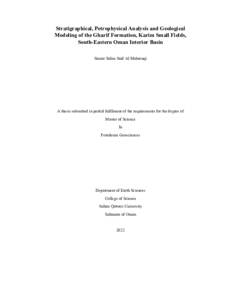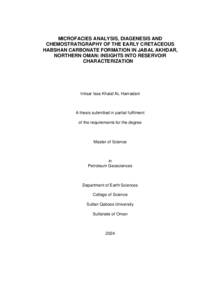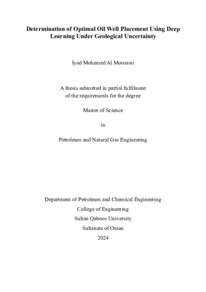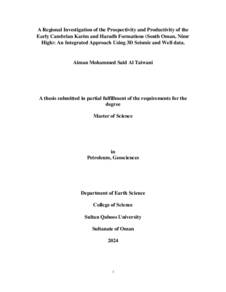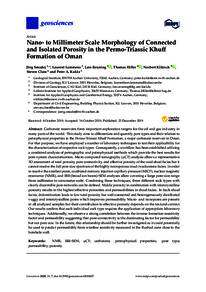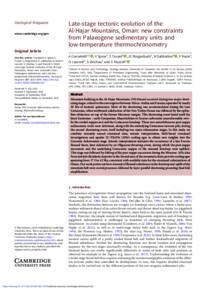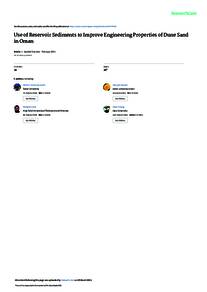Document
Stratigraphical, petrophysical analysis and geological modeling of the Gharif formation, Karim small fields, South-Eastern Oman interior basin.
Other titles
التحلي الطبقي والبتروفيزيائي و النمذجة الجيولوجية لتكوين غريف، حقل كريم الصغير، الحوض الداخلي جنوب شرق عمان
Publisher
Sultan Qaboos University.
Gregorian
2022
Language
English
Subject
English abstract
Karim Small Fields (KSF) block measuring about 70 km long and 25 km wide is
located along the eastern flank of the South Oman Salt Basin. Based on the facies
distribution and reservoir characteristics, the Gharif Formation is subdivide into
Lower, Middle and Upper Gharif members. In the Karim Small Fields block, the
Gharif Formation contains oil-bearing zones in the Lower and Middle Gharif
members. This study presents a stratigraphical, petrophysical analysis and 3D
geological (static) model. This study constructs a stratigraphical framework by
defining the lithofacies and lithofacies associations of the Gharif Formation of the
available core section. It also evaluates the rock properties, reservoir quality and
hydrocarbon potentiality from petrophysical analysis and static model of the Gharif
Formation within the Karim Small Fields block.
Core section measuring 18.2 m length covering only the uppermost part of the Middle
Gharif Member is used to conduct the stratigraphical analysis. Based on the
sedimentary structure and grain size of the core section, five lithofacies are
recognized; i) poorly cross-laminated coarse to granule sandstone, ii) planar laminated
coarse to granule sandstone, iii) trough cross-laminated coarse to medium-grain
sandstone, iv) rippled laminated fine-grain sandstone, and v) poorly cross-bedded
pebbly sandstone. Based on the lithofacies, two lithofacies associations are defined;
i) channel-fill facies association, and ii) crevasse splay facies association, deposited
by multichannel, low sinuosity braided river system.
A total of 17 wells with a basic conventional wireline logs were used to identify rock
types and lithologies, calculate shale volume, total and effective porosity,
permeability estimation fluids saturation, and fluid contacts of reservoir intervals for
different fields. The analogy well that is used for correlation is SM-84 as the core data
is only available for this well. This may create some uncertainty in the selected
petrophysical parameters used in the study. The neutron-density logs give a good
estimation of shale volume after correlation with the shale volume calculated from
core data. The density log is then used to calculate the total and effective porosity.
Based on petrophysical properties, four rock types were identified in the Gharif
Formation; including sand, heterolith, shale and tight sand. The fluid saturations were
calculated by the Indonesian equation due to the presence of shale units. For the
permeability estimation, the permeability transform is given according to the
polynomial equation y = -9795.7x4 + 8131.4x3 - 2418.7x2 + 316.12x - 13.731.
The oil-water contact in each field is determined from the deep resistivity log and
density log as the pressure data is not available in this study.
The thickness of sand bodies decreases from the eastern and southeastern part (source
area) towards the western and northwestern parts (basinal area) of the Karim Small
Fields.
Furthermore, the thickness variation in the Karim Small Fields block could be due to
erosion effects, salt withdrawal and salt dissolution, and distance from the source area.
Integration of all petrophysical analysis data led to the building of a consistent 3D
geological model. A grid size of 100 m x 100 m was selected for building the 3D Grid
for the structural framework. The total number of 3D grid cells is 30,810,780. The
Gharif Formation was subdivided into five stratigraphic zones based on the sand
bodies defined in the correlation section. The total number of vertical layers is 165.
Facies model of the Gharif Formation has been established from the reservoir rock
typing outcome using Truncated Gaussian Simulation. The property modeling
includes effective porosity modeling by Sequential Gaussian Simulation. The
volumetric calculations indicate that the total volume of oil in place is 52,680x10,3
sm3 for Karim Small Fields.
Member of
Resource URL
Arabic abstract
تقع منطقة امتياز رقم 6 لحقول كريم الصغيرة على طول الجناح الشرقي للحوض الملحي الجنوبي، ويبلغ طوله
حوالي 70 كم وعرضه 25 كم. تحتوي منطقة امتياز رقم 6 لحقول كريم الصغيرة على تكوين غريف الذي يخزن
النفط في الجزء الأوسط والعلوي لتكوين طبقيًا وبتروفيزيائيًا ونموذ ًجا جيولوجيًا ثلاثي
. تقدم هذه الدراسة تحليلاً
الأبعاد تم تنفيذهما لبناء إطار طبقي من خلال تحديد ترابطات الصخور وتقييم خصائص الصخور وجودة الخزان
والإمكانات الهيدروكربونية لتكوين غريف داخل منطقة الامتياز.
تم استخدام 18.2 م من العينات الصخرية المستخرجة من الحفرة لجزء غريف الأوسط لإجراء تحليل طبقي. من
البنية الرسوبية وحجم حبيبات العينة للقسم الأساسي لتكوين غريف الأوسط ، تم التعرف على خمس ارتباطات
صخرية: رقيق متقاطع خشن إلى حجر رملي حبيبي ، حجر رملي مستو خشن إلى حبيبي ، حجر رملي متقاطع
خشن إلى متوسط الحبيبات ، حجر رملي ناعم الحبيبات متموج و الحجر الرملي المرصوف بالحصى. وبما أن
العينات الصخرية لا يغطي سوى الجزء العلوي من جزء غريف الأوسط ، فقد تم تحديد اتحادين للارتباطات
الحجرية: رابطة ترسبات ملئ القناة وترسبات صدع النهر متعدد القنوات منخفض الانسيابية.
سجًلا كمية الطين الصخري، والمسامية الكلية والفعالة ، وتحديد تم استخدام ما مجموعه 17 سلكيًا تقليديًا لحساب
تركيب الصخور ، وتشبع السوائل ، وتقدير النفاذية ، الحد الفاصل بين النفط والماء في المكمن. إن البئر النموذجي
المستخدم للحسابات هو -84SM حيث أن العيانات الصخرية متاحة فقط لهذا البئر. تعطي سجلات الكثافة
والنيوترونات تقدي ًرا جيدًا لكمية الصخر الترابي بعد المقارنة مع كمية الصخر الترابي المحسوب من العيانات
الصخرية، وبالتالي يتم استخدام سجل الكثافة لحساب المسامية الإجمالية والفعالة. تم تحديد أربعة أنواع من
الصخور في تكوين غريف: الرمل ، الرمل المخلوط مع الحجر الطين الصخري، الطين الصخري والرمل
المضغوط. تم حساب تشبع السوائل بالمعادلة الإندونيسية بسبب وجود الطين الصخري. ولتقدير النفاذية ، تم
وفقً 13.731 - x316.12 + 2x2418.7 - 3x8131.4 + 4x-9795.7 = y احتسابها ا للمعادلة متعددة الحدود
يتم تحديد الحد الفاصل بين النفط والماء في كل حقل من سجل المقاومة العميقة وسجل الكثافة نظ ًرا لعدم توفر
بيانات الضغط في هذه الدراسة. تظهر حقول أرنب،غمر، غزر، كريم، سلوى، ورد، وزير و زهرة مؤشرات
على تراكم النفط في طبقات الرمال.
يتناقص توزيع المسطحات الرملية من الجزء الشرقي والشمالي الشرقي (منطقة المصدر) باتجاه الأجزاء الغربية
والشمالية الغربية (المنطقة القاعدية) من منطقة امتياز حقول كريم الصغيرة ، والمصدر الرئيسي للرواسب
لتكوين الغريف في الحوض الملحي الجنوبي هو مرتفغات حقف. علاوة على ذلك ، يتم تفسير اختلاف السماكة
الذي تم فحصه في الحقول المختلفة على أنه ناتج عن تأثيرات التعرية وسحب انحلال الملح.
أدى تكامل جميع بيانات التحليل البتروفيزيائي إلى بناء نموذج جيولوجي ثلاثي الأبعاد متسق. تم اختيار حجم
خلية 100 م × 100 م في بناء شبكة ثلاثية الأبعاد للإطار الهيكلي ، والعدد الإجمالي لخلايا الشبكة ثلاثية الأبعاد
هو (399 * 468 * 156 = 30810780). تكوين غريف مقسم إلى خمس تقسيمات داخلية لطبقات تكوين
غريف على أساس توزيع الأجسام الرملية المحددة في قسم التطابق والعدد الإجمالي للطبقات الرأسية هو .165
تم إنشاء نموذج لسحنات لتكوين غريف بناء على أنواع الصخور المحددة مسبقا باستخدام محاكاة غوسية
المتسلسلة. تشير الحسابات الحجمية إلى أن الحجم الإجمالي للنفط في حقل كريم الصغير هو 3,10x52,680
.sm3
حوالي 70 كم وعرضه 25 كم. تحتوي منطقة امتياز رقم 6 لحقول كريم الصغيرة على تكوين غريف الذي يخزن
النفط في الجزء الأوسط والعلوي لتكوين طبقيًا وبتروفيزيائيًا ونموذ ًجا جيولوجيًا ثلاثي
. تقدم هذه الدراسة تحليلاً
الأبعاد تم تنفيذهما لبناء إطار طبقي من خلال تحديد ترابطات الصخور وتقييم خصائص الصخور وجودة الخزان
والإمكانات الهيدروكربونية لتكوين غريف داخل منطقة الامتياز.
تم استخدام 18.2 م من العينات الصخرية المستخرجة من الحفرة لجزء غريف الأوسط لإجراء تحليل طبقي. من
البنية الرسوبية وحجم حبيبات العينة للقسم الأساسي لتكوين غريف الأوسط ، تم التعرف على خمس ارتباطات
صخرية: رقيق متقاطع خشن إلى حجر رملي حبيبي ، حجر رملي مستو خشن إلى حبيبي ، حجر رملي متقاطع
خشن إلى متوسط الحبيبات ، حجر رملي ناعم الحبيبات متموج و الحجر الرملي المرصوف بالحصى. وبما أن
العينات الصخرية لا يغطي سوى الجزء العلوي من جزء غريف الأوسط ، فقد تم تحديد اتحادين للارتباطات
الحجرية: رابطة ترسبات ملئ القناة وترسبات صدع النهر متعدد القنوات منخفض الانسيابية.
سجًلا كمية الطين الصخري، والمسامية الكلية والفعالة ، وتحديد تم استخدام ما مجموعه 17 سلكيًا تقليديًا لحساب
تركيب الصخور ، وتشبع السوائل ، وتقدير النفاذية ، الحد الفاصل بين النفط والماء في المكمن. إن البئر النموذجي
المستخدم للحسابات هو -84SM حيث أن العيانات الصخرية متاحة فقط لهذا البئر. تعطي سجلات الكثافة
والنيوترونات تقدي ًرا جيدًا لكمية الصخر الترابي بعد المقارنة مع كمية الصخر الترابي المحسوب من العيانات
الصخرية، وبالتالي يتم استخدام سجل الكثافة لحساب المسامية الإجمالية والفعالة. تم تحديد أربعة أنواع من
الصخور في تكوين غريف: الرمل ، الرمل المخلوط مع الحجر الطين الصخري، الطين الصخري والرمل
المضغوط. تم حساب تشبع السوائل بالمعادلة الإندونيسية بسبب وجود الطين الصخري. ولتقدير النفاذية ، تم
وفقً 13.731 - x316.12 + 2x2418.7 - 3x8131.4 + 4x-9795.7 = y احتسابها ا للمعادلة متعددة الحدود
يتم تحديد الحد الفاصل بين النفط والماء في كل حقل من سجل المقاومة العميقة وسجل الكثافة نظ ًرا لعدم توفر
بيانات الضغط في هذه الدراسة. تظهر حقول أرنب،غمر، غزر، كريم، سلوى، ورد، وزير و زهرة مؤشرات
على تراكم النفط في طبقات الرمال.
يتناقص توزيع المسطحات الرملية من الجزء الشرقي والشمالي الشرقي (منطقة المصدر) باتجاه الأجزاء الغربية
والشمالية الغربية (المنطقة القاعدية) من منطقة امتياز حقول كريم الصغيرة ، والمصدر الرئيسي للرواسب
لتكوين الغريف في الحوض الملحي الجنوبي هو مرتفغات حقف. علاوة على ذلك ، يتم تفسير اختلاف السماكة
الذي تم فحصه في الحقول المختلفة على أنه ناتج عن تأثيرات التعرية وسحب انحلال الملح.
أدى تكامل جميع بيانات التحليل البتروفيزيائي إلى بناء نموذج جيولوجي ثلاثي الأبعاد متسق. تم اختيار حجم
خلية 100 م × 100 م في بناء شبكة ثلاثية الأبعاد للإطار الهيكلي ، والعدد الإجمالي لخلايا الشبكة ثلاثية الأبعاد
هو (399 * 468 * 156 = 30810780). تكوين غريف مقسم إلى خمس تقسيمات داخلية لطبقات تكوين
غريف على أساس توزيع الأجسام الرملية المحددة في قسم التطابق والعدد الإجمالي للطبقات الرأسية هو .165
تم إنشاء نموذج لسحنات لتكوين غريف بناء على أنواع الصخور المحددة مسبقا باستخدام محاكاة غوسية
المتسلسلة. تشير الحسابات الحجمية إلى أن الحجم الإجمالي للنفط في حقل كريم الصغير هو 3,10x52,680
.sm3
Category
Theses and Dissertations

